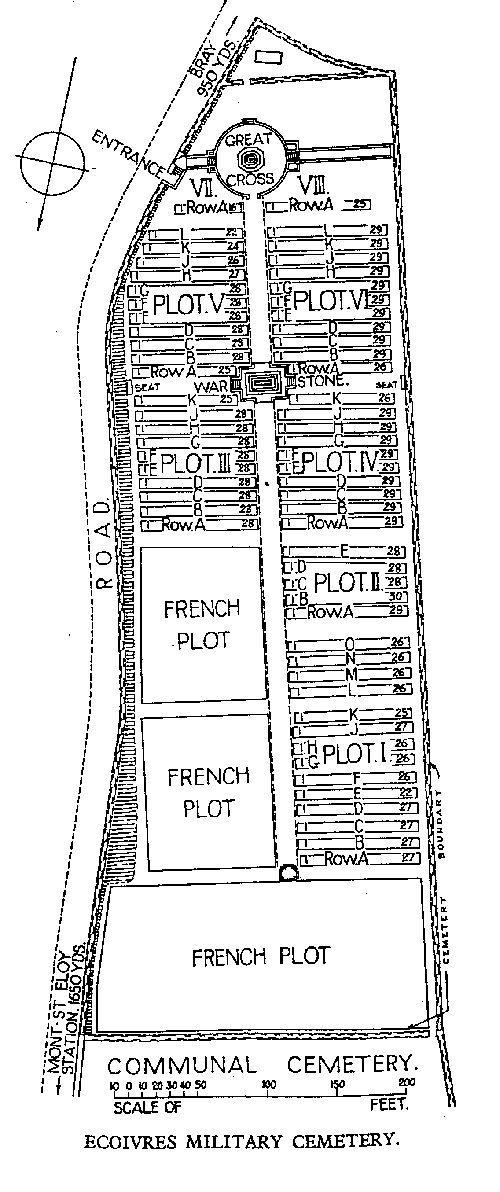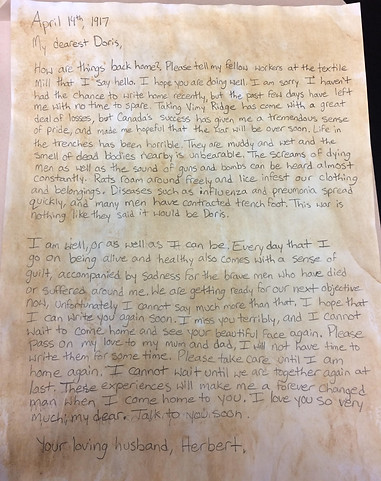
In Memory of Herbert Guest 1893-1917
Biography
Herbert Guest was a Private during the First World War. He was born March 19th, 1893 in Halifax, England to Alfred and Susan Guest. He later moved to Canada and became a worsted overlooker, working at a textile mill in Peterborough, Ontario. There, he lived with his wife Doris Hanson Guest. On January 20th, 1916, at the age of 22, he signed up in Peterborough to take part in the war. His term was supposed to last for a minimum of one year, or until the war between Britain and Germany was over, plus an additional 6 months after the termination of the war. He did not have any previous military experience. He joined the 93rd Battalion and his regimental number became 195579. On July 25th, 1916, he arrived in England on the SS Empress, and he was transferred to the 19th Canadian Infantry Battalion on September 15th, 1916. In his medical examination, taken on January 21st, 1916, he was described as 22 years and 10 months old, with a height of 5-foot-4-and-a-half inches, and a weight of 125 lbs. He had brown hair, blue eyes, and a fresh complexion. He had no distinctive marks or marks showing previous disease. His religion was Methodist. While he was serving, the 19th Battalion was in France, along The Western Front. The 19th Battalion fought many battles during the time Herbert was serving, including the Battle of Thiepval, Battle of Le Transloy, Battle of the Ancre Heights, and Vimy Ridge. Sadly, Herbert Guest passed away a short time after the Canadians took Vimy Ridge, on April 23rd, 1917. This was the day of the Attack on La Coulotte, part of the Arras Offensive, which was near the city of Arras, France.
Herbert Guest was buried at the Ecoivres Military Cemetery, in Mont St. Elois, a village in the department of the Pas-de-Calais, France. It is on high ground overlooking the battlefields of Vimy Ridge and the main Bethune-Arras Road. His grave reference is V. G. 26.

The SS Empress

Ecoivres Military Cemetary

The Ecoivres Military Cemetary plan
The 19th Canadian Infantry Battalion, CEF
The 19th Battalion was raised on November 6th, 1914 at Exhibition park, in Toronto, Ontario. It was then transferred to a station in Shorncliffe, England on May 23rd, 1915, and then to France on September 14th, 1915. There, it was active until April 30th, 1919, After the First World War had ended. The 19th Battalion was part of the 4th Infantry Brigade, and the 2nd Canadian Division. During the war, it played a large role, being included in nearly every major battle, including Vimy Ridge, Hill 70, Passchendaele, Battle of the Somme, and many more.

The cap badge of the 19th Canadian Infantry Battalion


Herbert's Attestation papers and medical examination

Herbert's name on page 6 of the Peterborough Book of Remembrance

Herbert's name on page 248 on the Canadian Book of Remembrance for World War One

Herbert's casualty sheet

Herbert's casualty report


click the play buttons to have the letters read to you
Fictional letters that portray what the war might have been like for a soldier and their next of kin

Town Square of Arras, France in February 1919
The Arras Offensive
The Arras Offensive, or the Second Battle of Arras took place between April 9th and May 16th, 1917. It was a series of attacks on German defenses that British troops had planned out to support a larger French offensive, in the area of Arras, France. Originally, Allied troops had planned for the offensive to take place in the spring, which was threatened in February when Russia decided not to take part. This left only the British and French against the Germans in an attempt to regain land. The Second Battle of Arras had two main phases, each with carefully planned attacks.
The first phase began on March 20th with the bombardment of Vimy Ridge, with British troops attempting to take the ridge, but failing to capture it. They did however, tire out German soldiers, and destroy some trenches and defensive measures such as barbed wire fences. On April 9th, two battles were carefully crafted to begin at roughly the same time. The Canadian Corps began their attack on Vimy Ridge, which lasted from April 9th to 12th, while British divisions began the First Battle of the Scarpe, which lasted from April 9th to 14th. In order to take Vimy Ridge, Canadian Corps commander Julian Byng, and General Arthur Currie spent months coming up with a strategy. They planned to advance behind a creeping barrage, and gave each unit specific goals that soldiers could follow even if an officer was killed, or communications broke down. The attack was successful, and it has become one of the proudest moments for Canadians during the First World War. The First Battle of the Scarpe began with the 12th British Division attacking from the east of Arras, taking Observation Ridge, and then pushing on to Feuchy and taking German Trenches, while the 3rd Division came up from the south. The main objective was taking the Monchyriegel, a trench between Feuchy and Wancourt, which was achieved by the 56th Battalion a few days after the surrounding villages were in British hands.
The second phase began afterwards, when commanders realized the reality of these objectives. They began by preparing for what was to come, by setting up casualty clearing stations, sending food to their soldiers, and building new roads and gun pits. Commanders were also faced with the decision of whether to keep exhausted soldiers on the front lines or replace them and risk not having enough manpower in case of an attack. The second phase consisted of many significant battles, including the Second Battle of the Scarpe, which occurred on the 23rd-24th of April, the Battle of Arleux, which occurred on the 28th-29th of April, and the Third Battle of the Scarpe, which occurred on the 3rd-4th of May. The objective of the Second Battle of the Scarpe was to attack east on both sides of the Scarpe river, and capture villages from Croisills to Gavrelle. It began with the 51st and 37th Divisions capturing the outskirts of Roeux Wood and western Greenland Hill, followed by the 63rd Division capturing Gavrelle. The 29th Division achieved their objective of capturing the west of Infantry Hill. Guèmappe was the objective of the 15th Division, but the village was not captured until the 50th Division captured the south of the Cojeul River. By the morning of April 24th, after strong German counter-attacks had occurred, the British were able to hold Gavrelle and Guèmappe. The Battle of Arleux had a principal objective of assisting the French offensive by tying down German reserves. British and Canadian troops launched the battle just north of Monchy-le-Preux, which continued for two days, with Germans delivering counter-attacks. The Germans launched seven attacks at Gavrelle, but were defeated by the strong 63rd Division of British troops. The 1st Canadian Division captured the village of Arleux-en-Gohelle, and the 2nd Canadian Division made progress in Oppy, Greenland Hill and between Monchy-le-Preux and Scarpe. The Third Battle of the Scarpe was scheduled to reach Wotanstellung, a major German defense system, at the same time as the Australian attack on Bullecourt. Commanders hoped that this two-pronged attack would force the Germans to be pushed back toward the east. Unfortunately, neither the British or Australian troops were able to make significant advances. They were forced to call off a day later after sustaining major casualties. Even though the attack failed, the British learned important lessons about close liaison being needed between tanks, artillery, and infantry that would later be used in the Battle of Cambrai later in 1917.
When the Arras Offensive was over, it was undoubted that the first few days were a major success for Britain. They suffered low casualties and captured many crucial points, making the longest advance in the history of trench warfare, but ultimately by the end of the battle, the British had suffered more than 150 000 casualties and gained little ground since the first few days. Although this battle was seen as a British victory, there were no significant impacts on strategic or tactical situations, and their fail to break through German defenses resulted in a stalemate once again.

A Canadian machine gun squad at Vimy Ridge

British machine gunners near Arras
